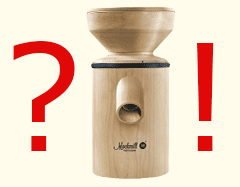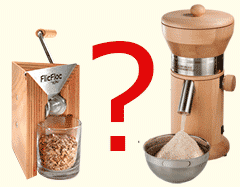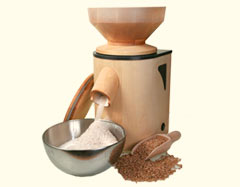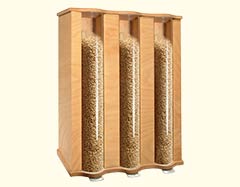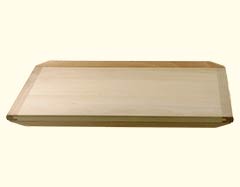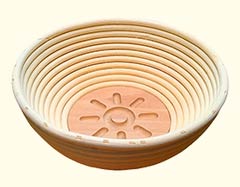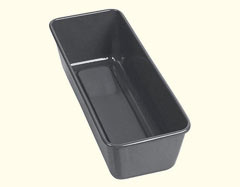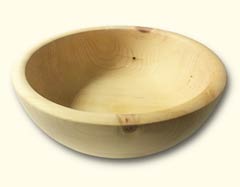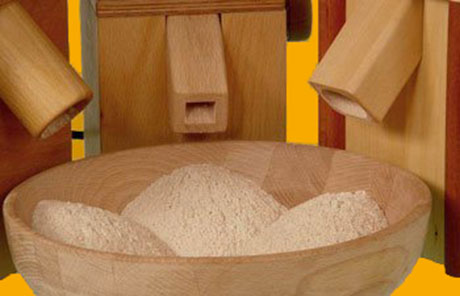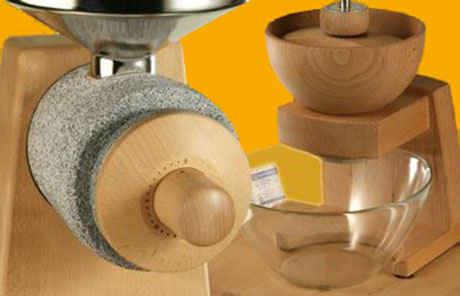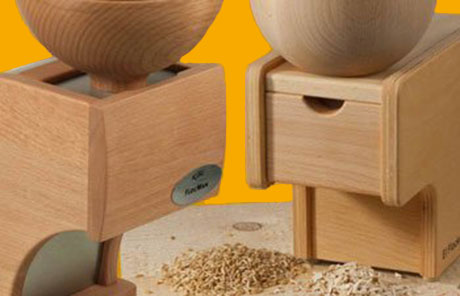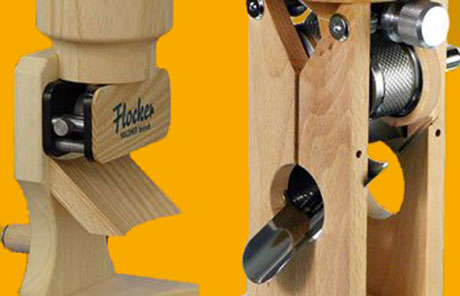Criteria of a Grain and Flour Mill for the Home
Milling science: Grain and Flour Mills for Home Use
Millstones
A matter of principle
- Corundum ceramics
- Electrocorundum or basalt magnesite bonded
- Natural stone (granite)
Most manufacturers use grinding stones made of corundum ceramic (corundum bound in ceramic mass) because such are extremely hard, durable and relatively insensitive. A so-called corundum-ceramic stone is a highly compacted and very hot (up to 2000°C) fired artificial stone, consisting of corundum and binding mass. During firing, the binder (e.g. sugar beet syrup) creates tiny bubbles that make the stone porous (not brittle!). As a result, the surface of this artificial stone always remains rough and thus "sharpened", even during abrasion. This stone has established itself in electric grain mills (since 1985) and has also proved its worth. Only a few manufacturers use the electrocorundum or basalt-magnesite stone (artificial stone made of natural (Naxos emery) or electrocorundum cast in magnesite bond and unfired), mainly in manually operated grain mills from Kornkraft and electric mills from WIDU AGRISAN (Salzburger Grain Mills) is the only manufacturer so far (as of 2021) to use its Granit Nature Stone
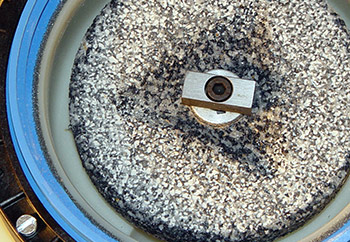 Grinding stone made of corundum ceramic at hawos Oktagon 1
Grinding stone made of corundum ceramic at hawos Oktagon 1
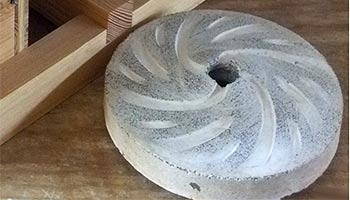 Grinding stone of corundum-magnesite at Widu Baeckermuehle
Grinding stone of corundum-magnesite at Widu Baeckermuehle
Millstone size
Larger = more grinding surface = mostly finer
The size of the millstone of a flour mill is not necessarily decisive, but it is advantageous for the fineness of the flour because of the larger grinding surface, which, however, requires more effort. The art of mill construction also consists in the precision of the millstones, the most perfect parallelism of the stones to each other and the optimal profiling (surface design or shape). Different stone shapes are used:
- Plane grinding stones or discs (for most electric mills)
- Conical grinders (mainly for hand mills)
- Combination of cone and disc mill (WIDU mills)
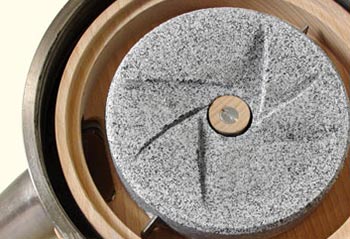 Grinding stone made of natural stone granite at MT5 by Salzburger
Grinding stone made of natural stone granite at MT5 by Salzburger
Grinding Chamber
Plastic or wood?
This question is important for some who are concerned with vibrations and charges of substances. Since the ground flour is swirled through the milling chamber before it is ejected, it could become statically charged in a milling chamber made of plastic. A certain amount of abrasion, although hardly measurable, can also be an argument against plastic. However, most manufacturers prefer plastic for reasons of cost and design simplification, except AGRISAN (Salzburger Grain Mills), WIDU and Waldner Biotech at its"Family
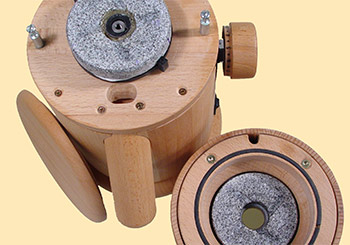 Wooden grinding chamber at Carina from Salzburger
Wooden grinding chamber at Carina from Salzburger
Casing
Optics important and very individual, but not a sign of quality
Neither the shape nor the material of the housing have any influence on the grinding quality, unless they are directly related to the grinder design. But it does have an influence on the noise development. A heavy housing (a lot of mass) reduces the intensity of the vibrations or sound waves. The shape (round or square) also plays a role. Round or polygonal enclosures are usually somewhat quieter than their rectangular counterparts.
Wood type
Fewer signs of use with hardwoods
The choice of wood type is a matter of taste. Hardwoods, mostly beech, are predominantly used because they are stable and quite fine-pored. Waldner also uses Swiss stone pine (Swiss stone pine = soft wood) because it has a mite-repellent effect. Over the years, however, the mite-repellent effect of stone pine wood fades. Alder (model wood) is also used occasionally, e.g. in the Waldner grain mill Single, probably on the one hand because it is a fashionable wood (20 years ago) with visual appeal, and on the other hand because it hardly reacts to climate fluctuations (humidity and temperature) due to its dimensionally stable properties. Walnut, cherry or other woods are often available as luxury versions of standard models.
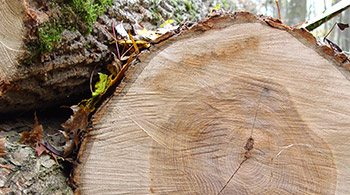 Grain and Flour Mills mainly made of hardwood
Grain and Flour Mills mainly made of hardwood
Finish
Oiled more natural - lacquered easier to care for
Oil surface materials such as hard oils, hard waxes and natural oils are durable to a limited extent. If the grain mill is cleaned too often with a damp cloth, it may be necessary to re-oil or re-wax the housing of the grain mill in order to restore the brilliance of the oil surface. Oils and waxes are transpiring and thus benefit the wood's properties. The wood can breathe, but also reacts more sensitively to climate fluctuations. Wood stains are also breathable, but offer more surface protection because they form a wafer-thin layer that is more resistant to abrasion. Water-based varnishes offer the most durable protection and are the easiest to maintain because they form a thick, stable and very smooth layer. They have little to no breathability. It could be seen as an advantage that the wood underneath does not react as quickly to climate changes in the living area.
 Surfaces mostly made of modified beeswax or natural oils
Surfaces mostly made of modified beeswax or natural oils
Cleaning
Cleaning only necessary after gluing the grinding stones together
As a rule, cleaning the grain mill and the milling chamber is rarely necessary. However, it could happen that your ground material was too moist and therefore the grinding stones are smeared and prevent the flour from being ejected. If cereals with a high oil content, such as rye, oats or barley, are milled pure on the finest setting, sticking can also be caused by escaping oil. Now you do not need to dismantle the mill right away, but try to grind with dry brown rice (no parboiled bagged rice!) on medium-coarse to coarsest setting. Coarser settings produce higher vibrations that shake the milling chamber clean. The dry rice grains act like sandpaper.
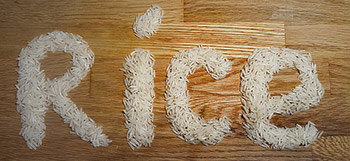 Clean the milling chamber with rice.
Clean the milling chamber with rice.
Pic: pixabay.com@monsterkoi
Flour fineness
Important, but often inadequate manufacturer information
The degree of fineness is usually indicated by a sieve sample according to DIN 10765. 80 % of the ground material should fall through the mesh of the fine sieve, mesh size 0.3 mm. All mills with one of the three grinding stones described (Naxos basalt in magnesite bond, granite and corundum ceramic) achieve this without any problems. Most of them grind much finer. However, the sieve test is problematic insofar as it always depends on the particular type of grain being measured. With spelt it is always very easy to grind finely, which is why people like to demonstrate with spelt at trade fairs. Then there are very different types of wheat, and depending on the variety, the milled wholemeal flour is more grainy or velvety.
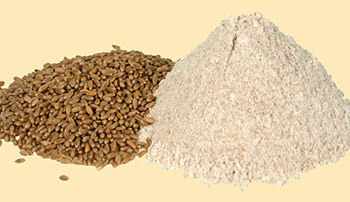 Stone mills grind fine enough for cakes and pies, but not comparable to bagged flour.
Stone mills grind fine enough for cakes and pies, but not comparable to bagged flour.
Grinding efficiency
The amount per minute does not tell the whole story.
The value for the grinding capacity "fine" shows you how much flour can be ground on the finest setting, but not how finely the flour is ground. So this value alone says relatively little. Do not be confused by any performance formulas that say nothing or relatively little about the fineness of the flour! The value for the grinding capacity "coarse" does not tell you much either. On the coarsest setting, the grains often fall out unground.
 Faster does not equal finer.
Faster does not equal finer.
Pic: pixabay.com@dreamtemp
Engine power
High performance not always advantageous
If you want to grind hard grains such as maize and chickpeas or kilos of grain, we recommend grain mills from 200 g/min or with powerful motors from 550 watts power input. For frequent grinders such as bakers and large-scale wholefood kitchens, there are commercial mills that are specially designed for continuous use and are usually also powered by high voltage current. For bread baking at home, 100 g/min. mills are perfectly adequate. They grind just as finely as the more powerful mills. The material to be ground is also less heated with larger grinding quantities.
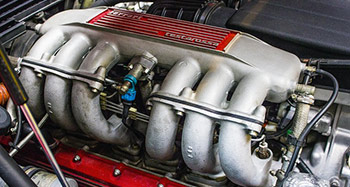 Stronger does not mean better!
Stronger does not mean better!
Pic: pixabay.com@akiragiulia
Loudness
Grain and Flour Mills are all noisy, but not as noisy as stand mixers (blenders).
Unfortunately, the data in dB(A) are not very meaningful, as no manufacturer states with which ground material the value was achieved and according to which standard. The volume depends on the mill design, the weight and the hardness of the ground material. And the coarser the grind, the louder the grinding noise, as greater vibrations are generated. Putting on the hopper lid has a particularly noise-reducing effect.
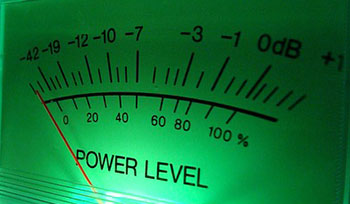 Unfortunately, electric mills are all loud, but some love the sound.
Unfortunately, electric mills are all loud, but some love the sound.
Pic: pixabay.com
Oilseeds
Oilseeds only mixed with cereals
Oil seeds can be conditionally ground with millstones. The finer the setting, the smaller the grindable quantity, as the millstones heat up and the oil escapes from the seeds above a certain temperature. If possible, oilseeds should be ground mixed with grain. However, if you want to grind oilseeds pure, you are usually better off with a grain mill with a steel grinder. Such mills usually cause fewer problems and are easier to clean. An exception are the WIDU mills, which can be used to grind fine-grained oilseeds, hulled sunflower seeds and coconut flakes in addition to grain.
Exception: WIDU grain mills also grind hulled sunflower seeds or pine nuts.
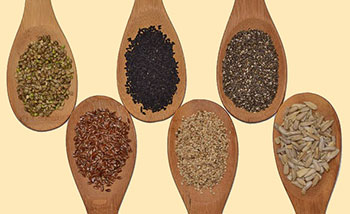 Oilseeds nothing for grain mills with stone grinding mechanism, exception WIDU grain mills
Oilseeds nothing for grain mills with stone grinding mechanism, exception WIDU grain mills
Pic: pixabay.com@ulleo
Spices and nuts
Grain and Flour Mills are not spice mills.
Hard, low-oil spices, coriander, caraway or mustard can be ground with a stone mill, but larger quantities cannot be ground at the finest setting because of the stronger heating. Soft leaf spices, even if dried, can be partially ground with steel grinders, but not satisfactorily in our experience. As with oilseeds, finely chopped nuts can at best be ground mixed with grain, but not pure. The grinding stones would immediately smear because nuts contain a lot of oil.
Exception: WIDU grain mills can also grind chopped nuts.
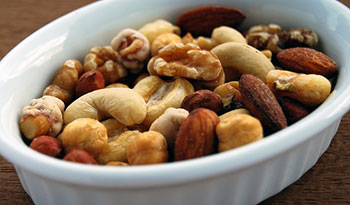 Stone mills cannot grind nuts.
Stone mills cannot grind nuts.
Pic: pixabay.com
Gluten free
What are grain mills "gluten-free" ground for?
Gluten are grain components that cause reactions in gluten allergies (e.g. coeliac disease). That is why there are also "gluten-free" milled grain mills. For cost reasons, grain mills are ground with wheat as standard. For people who do not tolerate gluten, most mill manufacturers also offer "gluten-free" milled cereal mills. These are ground with maize or rice. Whether the grain is ground "gluten-free" or "not gluten-free" is irrelevant for the further use of the grain mill in terms of quality. Or to put it more simply: "Gluten-free" milled cereal mills are no better or worse in quality than normally milled cereal mills.
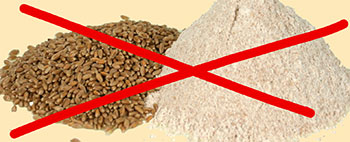 Gluten-free grain mills are not better or healthier.
Gluten-free grain mills are not better or healthier.

